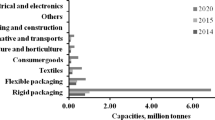Abstract
Waste oils and greases from commercial restaurants, also known as trap grease, are potential feedstocks for sustainable biodiesel production. A significant challenge in producing biodiesel from trap grease is the very strong and offensive odor it can possess. The odor can be attributed to several factors including the volatile chemical compounds created during fermentation and biodegradation of oils and fats. Sensory assessment evaluations were performed on several samples of trap grease, trap grease biodiesel, and reference materials to illustrate different aspects of their odor profile and to gain a better understanding of the odor sources so odor mitigation strategies can be developed and evaluated. Short-chain free fatty acids have been identified as a significant component in trap grease and the odor descriptors commonly associated with short-chain free fatty acids were identified in the trap grease samples evaluated. Biodiesel was prepared from trap grease and found to have a similar odor profile as petrodiesel and other commercially available biodiesels blends. The results from this study show that the odor from trap grease can be mitigated during pretreatment and biodiesel conversion steps and does not represent a significant obstacle to commercialization.
Similar content being viewed by others
References
ASTM (2004) American Society of Testing and Measurement (ASTM) E 2263-04 Standard test method for paired preference test. ASTM International, Conshohocken
Baranauskiene R, Venskutonis RP, Demyttenaere JCR (2003) Sensory and instrumental evaluation of catnip (Nepeta cataria L.) aroma. J Agric Food Chem 51:3840–3848
Canakci M (2007) The potential of restaurant waste lipids as biodiesel feedstocks. Bioresour Technol 98(1):183–190
Dias JM, Alvim-Ferraz MCM, Almeida MF (2009) Production of biodiesel from acid waste lard. Bioresour Technol 100:6355–6361
Encinar JM, Sanchez N, Martinez G, Garcia L (2011) Study of biodiesel production from animal fats with high free fatty acid content. Bioresour Technol 102:10907–10914
González-Córdova AF, Vallejo-Cordoba B (2001) Quantitative determination of short-chain free fatty acids in milk using solid-phase microextraction and gas chromatography. J Agric Food Chem 49(10):4603–4608
Grueb H, Gatfield JL (1989) Generation of flavor components by microbial fermentation and enzyme technology. In: Min DB, Smouse TH (eds) Flavor chemistry of lipid foods. The American Oil Chemists’ Society, Champaign
Guyot C, Bonnafont C, Lesschaeve I, Issanchou S, Voilley A, Spinnler HE (1996) Effect of fat content on odor intensity of three aroma compounds in model emulsions: a-decalactone, diacetyl, and butyric acid. J Agric Food Chem 44:2341–2348
Janaun J, Ellis N (2010) Perspectives on biodiesel as a sustainable fuel. Renew Sustain Energy Rev 14(4):1312–1320
Karmakar A, Karmakar S, Mukherjee S (2010) Properties of various plants and animal feedstocks for biodiesel production. Bioresour Technol 101:7201–7210
Knothe G, Steidley KR (2009) A comparison of used cooking oils: a very heterogeneous feedstock for biodiesel. Bioresour Technol 100:5796–5801
Kondamudi N, Mohapatra SK, Misra M (2008) Spent coffee grounds as a versatile source of green energy. J Agric Food Chem 56:11757–11760
Mahlke IT, Thiesen PH, Niemeyer B (2007) Chemical indices and methods of multivariate statistics as a tool for odor classification. Environ Sci Technol 41(7):2414–2421
Maraval I, Mestres C, Pernin K, Ribeyre F, Boulanger R, Guichard E, Gunata Z (2008) Odor-active compounds in cooked rice cultivars from camargue (france) analyzed by GC-O and GC-MS. J Agric Food Chem 56:5291–5298
Meilgaard M, Civille GV, Car BT (1999) Sensory evaluation techniques. CRC Press, Washington DC
Pham AJ, Schilling MW, Yoon Y, Kamadia, VV, Marshall DL (2008) Characterization of fish sauce aroma-impact compounds using GC-MS, SPME-Osme-GCO, and stevens' power law exponents. J Food Sci 73(4):C268–C274
Servili M, Conner JM, Piggott JR, Withers SJ, Paterson A (1995) Sensory characterisation of virgin olive oil and relationship with headspace composition. J Sci Food Agric 67:61–70
Thompson JG, Bertman S, Hill S, Kushner L, Miller JB (2012) Using headspace solid phase microextraction to evaluate the odor compounds in trap grease feedstock for biodiesel. Biomass Bioenergy 43:36–41
van Ruth SM, O'Connor CH (2001) Evaluation of three gas chromatography-olfactometry methods: comparison of odour intensity-concentration relationships of eight volatile compounds with sensory headspace data. Food Chem 74:341–347
Varming C, Peterson MA, Poll L (2004) Comparison of isolation methods for the determination of important aroma compounds in black currant (Ribes nigrum L.) juice, using nasal impact frequency profiling. J Agric Food Chem 52:1647–1652
Acknowledgments
This work was supported by the US Department of Energy (DE-FG3608GO88049).
Author information
Authors and Affiliations
Corresponding author
Rights and permissions
About this article
Cite this article
Thompson, J.G., Bertman, S. & Miller, J.B. Sensory Odor Evaluation of Trap Grease and Trap Grease Biodiesel. Chem. Percept. 6, 86–91 (2013). https://doi.org/10.1007/s12078-013-9145-0
Received:
Accepted:
Published:
Issue Date:
DOI: https://doi.org/10.1007/s12078-013-9145-0




